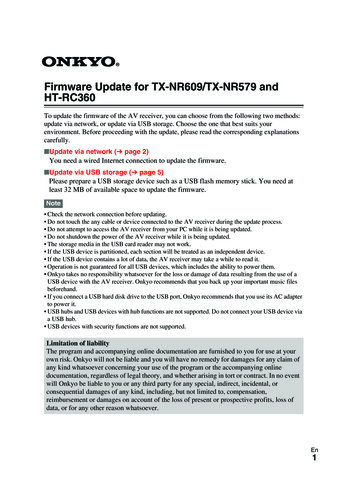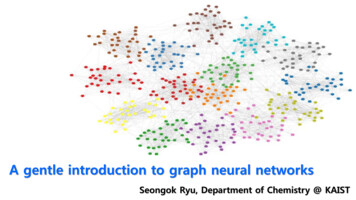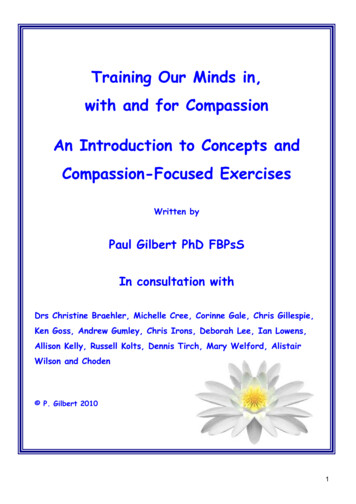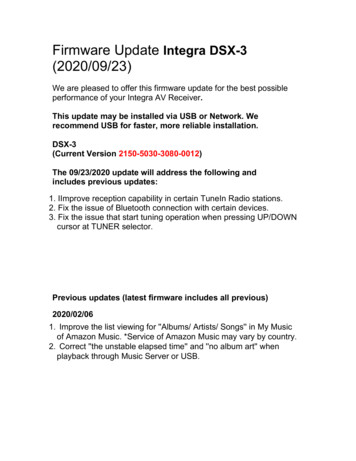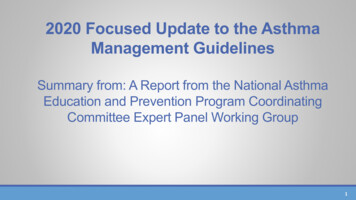
Transcription
2020 Focused Update to the AsthmaManagement GuidelinesSummary from: A Report from the National AsthmaEducation and Prevention Program CoordinatingCommittee Expert Panel Working Group1
Timeline for Asthma Guidelines 2020 Update2
The 2020 Focused Update to the 2007 Asthma Guidelines Six topics were updated: Fractional Exhaled Nitric Oxide (FeNO) in Diagnosis, Medication Selection, and MonitoringTreatment Response in Asthma Remediation of Indoor Allergens (e.g., Dust Mites) in Asthma Management Immunotherapy and the Management of Asthma Bronchial Thermoplasty (BT) in Adult Severe Asthma Adjustable Inhaled Corticosteroid Dosing in Recurrent Wheezing and Asthma Long-Acting Muscarinic Antagonists in Asthma Management as Add-on to Inhaled Corticosteroids Used GRADE Methodology to assess the certainty of the evidence and strength ofrecommendations Limited use of Expert Opinion and extrapolation of data across populations or age ranges Addressed pre-specified key questions using the best available evidence3
Other Topics Considered butNot Included in the Update* Prevention of Asthma Biomarkers (other than FeNO) Asthma Severity Classification Biologics Asthma Treatment Plans Role of Community HealthWorkers Asthma Heterogeneity (endotypesand phenotypes) Adherence LABA Safety Step Down from MaintenanceTherapy*As determined in the 2014‒15 Needs Assessment4
Members of the Expert Panel Michelle M. Cloutier (Chair) Jerry Krishnan Alan Baptist Robert F. Lemanske Kathryn Blake Daniel R. Ouellette Edward Brooks Wilson Pace Tyra Bryant-Stephens Michael Schatz Emily DiMango Jim Stout Anne Dixon Stephen Teach Kurtis S. Elward Craig A. Umscheid Tina Hartert5
GRADE MethodologyGrading of Recommendations Assessment, Development, and Evaluation(GRADE) An internationally accepted framework to determining the quality or certainty ofevidence and the direction and strength of a recommendation Used to review the evidence for patient-important outcomes across studies, tomake judgments about certainty of evidence, and to develop recommendations 2 main components to GRADE Evidence Profiles used to determine certainty of evidence based for critical andimportant outcomes Evidence to Decision Tables used to make final recommendation6
GRADE Methodology4 types of recommendations are possible A recommendation can be “for” or “against” an intervention A “for” or “against” recommendation can be “strong” or “conditional” Implications for individuals and clinicians are shown belowStrong Recommendation ForConditional Recommendation ForFor individuals with asthmaMost individuals would want this courseof action and only a small proportionwould not.Most individuals in this situation wouldwant the suggested course of action, butmany would not.For cliniciansMost individuals should receive theintervention.Different choices will be appropriate forindividuals consistent with their values andpreferences. Use shared decision-making.7
FeNO in Asthma ManagementKey Questions Accuracy for diagnosing asthma in individuals 5 years? Clinical utility of FeNO for asthma management in 5 years? Selecting medications Monitoring treatment effects Monitoring disease activity Accuracy of FeNO in children ages 0‒4 years in predicting developmentof subsequent asthma?8
Expert Panel Recommendations: FeNORecommendAs an adjunct in the evaluation process to diagnose asthma Conditional RecommendationModerate CertaintyAs part of ongoing asthma monitoring Conditional RecommendationLow Certainty9
Expert Panel Recommendations: FeNORecommend againstUse in isolation to assess asthma control, predict future exacerbations, orassess exacerbation severity Strong RecommendationLow CertaintyTo predict the future development of asthma in children ages 0‒4 years Strong RecommendationLow Certainty10
Comments on FeNO RecommendationsRole in asthma diagnosis Use only as an adjunct test if diagnosis uncertainRole in asthma management Useful to follow disease activity Useful in medication management with regular testing Not a stand-alone test to assess control, predict future exacerbations, or assessexacerbation severityImportant considerations Levels affected by a variety of factors (ICS, smoking, age, allergic sensitization) Cut offs need to be refined and validated (in different ethnic groups, in those withcomorbidities) Should not be a routine office test in primary care settings without strong specialty support11
Indoor Allergen Mitigation in Asthma ManagementKey Question Effectiveness of interventions to reduce or remove indoor inhalantallergens?12
Expert Panel Recommendations: Allergen MitigationRecommendIn those with symptoms and/or sensitization and exposure:Multicomponent allergen-specific mitigation Conditional Recommendation Low CertaintyIntegrated pest management as a single or as part of a multi-component mitigation intervention Conditional Recommendation Low CertaintyImpermeable pillow/mattress covers only as part of a multi-component mitigation intervention Conditional Recommendation Moderate Certainty13
Expert Panel Recommendations: Allergen MitigationRecommend againstAllergen mitigation in those with no symptoms and/or sensitization relatedto exposure to a specific allergen as part of routine asthma management Conditional Recommendation Low Certainty14
Comments on Allergen Mitigation RecommendationsRequires exposure, with allergy symptoms and/or sensitizationCertainty of evidence mostly low Bias, absence of blinding, small sample sizes, imprecision No standardization of outcome measures and interventions (esp. multi-component interventions) Harms small apart from cost May distract from other aspects of therapy Interventions may have other public health benefits15
Role of Subcutaneous (SCIT) and Sublingual (SLIT)Immunotherapy in the Treatment of Allergic AsthmaKey Question What is the efficacy and safety of SCIT and SLIT?16
Expert Panel Recommendation:SCIT and SLIT in Allergic AsthmaRecommendSCIT as an adjunct to standard pharmacotherapy Conditional Recommendation Moderate CertaintyAdults and children ( 5 years of age)Mild to moderate allergic asthmaAsthma under control at the initiation, build up, and during maintenance ofimmunotherapy17
Expert Panel Recommendations:SCIT and SLIT in Allergic AsthmaRecommend againstSublingual immunotherapy Conditional Recommendation Moderate Certainty18
Comments on Immunotherapy Recommendations SCIT Importance of shared decision-making– Benefits of SCIT are small improvements in symptoms and QOL, reduction in long-termmedications– May improve co-morbid allergic conditions– Risk of systemic reactions Optimize control, avoid in severe asthma, administer in clinical setting SLIT Limited number of allergens have FDA approval, and only for allergic rhinoconjunctivitis– May have some benefit in individuals with allergic rhinoconjunctivitis and asthma Studies show trivial benefit on critical outcomes in asthma– May reduce use of quick relief and controller medication19
Bronchial Thermoplasty (BT) in Asthma ManagementKey Question What are the benefits and harms of using BT in addition to standardtreatment for the treatment of adult patients (18 years and older) withasthma?20
Expert Panel Recommendation:Bronchial ThermoplastyRecommend againstUse of bronchial thermoplasty Conditional Recommendation Low CertaintyAdults with persistent asthma21
Comments on Bronchial ThermoplastyRecommendation Studies did not include individuals who received LAMA, environmentalinterventions, and newer biologic agents Optimize medications and address comorbidities before considering BT Carefully consider and discuss risks and benefits with individual patient Adults with persistent asthma who place a low value on harms (short-term worsening symptoms and unknown long-term side effects) and ahigh value on potential benefits (improvement in quality of life, a smallreduction in exacerbations) might consider BT If BT is performed, should be in context of registries or ongoing clinicaltrials22
Medications: Step Therapy Approach Preferred choices indicate the best management options supported bythe evidence reviewed by the Expert Panel. When the available evidence was insufficient or did not change aprevious recommendation, the preferred options were left unchangedfrom the EPR-3 step diagrams. Alternative options represent management options that have beenshown to be less effective than the preferred option(s) or have morelimited evidence compared with the preferred option(s). However, theymay still be appropriate in some patients.23
Inhaled Corticosteroids (ICS) in Asthma ManagementKey Questions In children 0–4 years with recurrent wheezing, what is the comparativeeffectiveness of intermittent ICS compared to no treatment,pharmacologic, or nonpharmacologic therapy? In individuals 5 years of age and older with persistent asthma, what isthe comparative effectiveness of Intermittent ICS compared to ICS controller therapy? ICS with LABA used as both controller and quick-relief therapy compared toICS with or without LABA used as controller therapy?24
Expert Panel Recommendations: ICSRecommendShort course of daily ICS at the onset of a respiratory tract infectionwith SABA as needed for quick-relief therapy. Conditional recommendation High certaintyChildren ages 0–4 years with recurrent wheezing triggered byrespiratory tract infections and no wheezing between infections25
Comments on Short-term Use of ICS Use in children 0‒4 years who have had three or more episodes ofwheezing triggered by respiratory tract infections in their lifetime or twoin the past year26
Expert Panel Recommendations:Short-Term Increases in ICSRecommend againstA short-term increase in the ICS dose for increased symptoms ordecreased peak flow Conditional recommendation Low certainty evidenceIndividuals ages 4 years and older who are likely to be adherent todaily ICS treatmentMild to moderate persistent asthma
Comments on Short-term Increases in ICS A short-term increase in ICS dose defined as a doubling, quadrupling, orquintupling of the regular daily dose
Expert Panel Recommendation: ICSRecommendEither daily low-dose ICS and as-needed SABA for quick-relief therapyor as-needed ICS and SABA used concomitantly Conditional recommendation Moderate certaintyIn individuals ages 12 years and olderMild persistent asthma29
Expert Panel Recommendation:Single Maintenance and Reliever Therapy (SMART)RecommendICS-formoterol in a single inhaler used as both daily controller andquick-relief therapy Strong recommendation High certainty ages 12 years and older Moderate certainty ages 4–11 yearsIndividuals ages 4 years and olderModerate to severe persistent asthma30
Comments on SMART Low dose ICS-formoterol (Step 3) and Medium dose ICS-formoterol(Step 4) Formoterol is specifically recommended as the LABA31
Long Acting Muscarinic Antagonists (LAMA)in Asthma ManagementKey Questions In individuals 12 years of age and older with uncontrolled, persistentasthma, what is the comparative effectiveness of LAMA Compared to other controller therapy as add-on to ICS? As add-on to ICS controller therapy compared to placebo or increased ICSdose? As add-on to ICS plus LABA compared to ICS plus LABA as controllertherapy32
Expert Panel Recommendations: LAMARecommendAdd LAMA to ICS controller therapy compared to continuing the samedose of ICS alone Conditional Recommendation Moderate CertaintyAdd LAMA to ICS-LABA Conditional Recommendation Moderate CertaintyIndividuals ages 12 years and olderUncontrolled persistent asthma33
Expert Panel Recommendations: LAMARecommend AgainstAdding LAMA to ICS compared to adding LABA to ICS. Conditional Recommendation Moderate CertaintyIndividuals ages 12 years and olderUncontrolled persistent asthma34
Comments on LAMA Combination ICS-LABA is preferable to ICS-LAMA Similar benefits Concern of greater harms with ICS-LAMA versus ICS-LABA If ICS-LABA is not used (Steps 3 and 4), ICS-LAMA is an alternateapproach Tiotropium used in all but one study and is the only LAMA that iscurrently FDA approved for asthma Individuals at risk for urinary retention or with glaucoma should notreceive this therapy35
Comments on FeNO Recommendations. Role in asthma diagnosis Use only as an adjunct test if diagnosis uncertain. Role in asthma management Useful to follow disease activity



